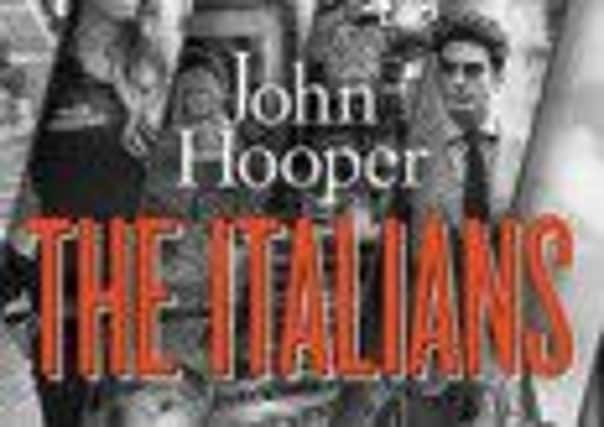Book review: The Italians by John Hooper


The Italians
by John Hooper
Allen Lane, 318pp, £20
More than half a century ago, Luigi Barzini, an Italian diplomat and journalist, wrote a book entitled simply, like this one, The Italians. He followed it with another, From Caesar to the Mafia, and together, they offer the most lucid and intelligent picture and analysis of Italian history, life and culture. His father, also a successful journalist, had been a Fascist, supporting Mussolini to the bitter end, but though the young Luigi has helped ghost Mussolini’s autobiography in 1928, he turned against the regime and was briefly imprisoned and then barred from public life. Nevertheless he offered one of the most perceptive examinations of Il Duce and his ramshackle regime.
I mention Barzini, to whose books I have often returned, because, excellent as they remain, much has changed in Italy over the last 50 years, and John Hooper, Italian correspondent of the Economist for the last 15 of them, has in a sense produced a companion volume, bringing them up to date. Just as the shadow of Mussolini hung over Barzini’s book – though it was written almost twenty years after the dictator’s downfall – so the central political figure of Hopper’s is Silvio Berlusconi. Time plays tricks on us all, and it is surprising to realise that Berlusconi, who first became Prime Minister in 1994, had dominated modern Italian politics – and governed the country (insofar as Italy can be governed) for almost as long as the self-styled “Fascist Era” lasted.
Advertisement
Hide AdWriting a political column in this newspaper, I described Berlusconi 20 years ago as “Mussolini in a blue blazer”, and nothing in his subsequent career has caused me to change my mind. If Barzini saw Mussolini essentially as an example of the “operatic tenor” in whom Italians have always delighted, Berlusconi has been the celebrity showman of the television age; and even now, despite his conviction for tax fraud, and his other legal problems, he may not be finished yet. Again, Hooper recognises that, like Mussolini, Berlusconi has achieved little of what he promised to achieve; yet, as with Barzini and Il Duce, he can’t withhold as certain grudging admiration for him. Both men gave the Italians what many wanted: a good show.
There are evident differences between Barzini and Hooper, The former wrote from the inside looking out, the latter from the outside looking in. But the condition of Italy is very different too. Barzini was writing during the years of the “economic miracle” when Italians were becoming more prosperous than ever. The First Republic, dominated for more than 40 years by the Christian Democrats, provided stability. (Governments kept falling, but were always resurrected with the same parties and the same politicians in office, even if in different roles.) Italy was firmly committed to the Atlantic Alliance, with the large Communist Party excluded from national government, and to the European Community that was on the way to becoming an ever-closer union.
That regime of the established parties collapsed in scandal and charges of widespread corruption soon after the end of the Cold War. The socialist prime minister Bettino Craxi (Berlusconi’s first sponsor) fled the country to avoid imprisonment, and almost all the parties changed their names. The rise of the Northern League even seemed to threaten the break-up of Italy, and revelations of links between democratic politicians and the Mafia provoked even deeper disillusionment and discontent. Denied the usual option of devaluation by membership of the Eurozone, the economy stagnated; and then came the global financial crash and the years of austerity imposed by Brussels and the European Central Bank. It is this less happy Italy that Hooper persuasively describes.
His love for the people and the country is evident, his exasperation likewise. Italy is still beautiful, living there still mostly delightful, but ... but… but. Italy has an extensive – and expensive – welfare state, but few Italians regard the state with respect; most do so with suspicion. There is an admirable public spirit, but it is mostly local. Meanwhile, the gap between rich and poor widens, though that between the North and the South or Mezzogiorno may be closing. Interpretation of national statistics is never easy; measurement of Italy’s GDP depends on whether you include criminal activity in the figures. In any case Italian statistics are even less reliable than British ones – and that’s saying a good deal.
Nevertheless Hooper argues that, despite the influences of history and geography, Italy is a more securely united country than many Italians suppose. Breakaway political movements have got nowhere; they tend to flourish briefly and then wither. Language is one unifying force. Even though dialects still flourish, the proportion of people who regularly speak standard Italian is far higher than it used to be. Then, as Hooper remarks, almost all Italians have been reared in a Roman Catholic culture; even those who no longer attend Church can’t escape this. There is too a uniform system of education.
Italy remains the most fascinating of countries, often perplexing and yet always engaging. Hooper does it justice. People who don’t know Italy will find this book a splendid introduction. Those who know and love the country will find much that is new as well as familiar, much that will have them nodding in agreement, some observations that will meet with the response , “not to my mind”. It deserves to sit happily on the bookshelf beside Barzini; and that is high praise.